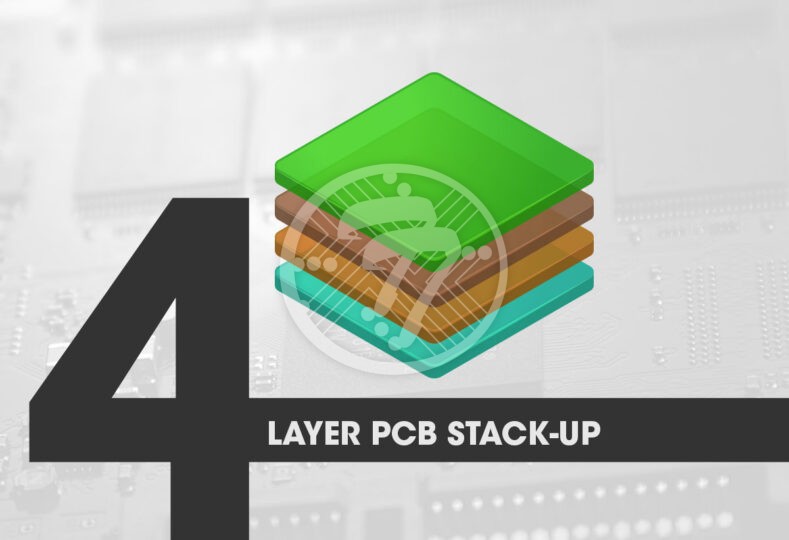Standard 4-Layer PCB Stack-up: Design, Fabrication, and the cost of manufacturing!

With miniaturized electronic products becoming ubiquitous, the need for small circuit boards is on the rise. Multilayer circuit boards are therefore the order of the day. A 4-layer PCB stackup is becoming increasingly common. Let us look at the 4-Layered PCB in detail.
What is 4-layer PCB Stackup?
As its name suggests, a 4-layered PCB comes with 4 layers, these include a top layer, a bottom layer & 2 inner layers.
Of these 4 layers, 2 are signal layers, one VCC & the other GND.
Typically, the inner layers are used as power & GND, while the outer layers are used for routing of signals as well as for component placement. With the inner layers used as power and GND planes you can be sure that EMI emissions will be less, and the quality of signal will be robust.
4 Layer PCB Advantages
The 4-layered PCB offers several advantages, including but not limited to:
- Improved routing of signals
- Better EMI shielding
- Improved thermal control
- High assembly density
- Lends itself to compact designs and to miniaturization
YOU MAY ALSO LIKE: Single Layer VS Multilayer PCB
Structure of standard 4-Layer PCB design stack up
There can be 3 ways in which these can be stacked up
Option 1
- Top Layer – Signal Layer
- Inner Layer 1- Power Layer
- Inner Layer 2 – Ground Layer
- Bottom Layer – Signal Layer
It is important to note that the less the distance between the power and the ground layer, the less will be the impedance.
Option 2
- Top Layer – Power Layer
- Inner Layer 1- Signal Layer
- Inner Layer 2 – Signal Layer
- Bottom Layer – Ground Layer
In this option, the power and the ground layer acts as a shield for the inner signal layers. However, on account of the distance between the power and ground layer, the plane impedance tends to increase.
Option 3
- Top Layer – Signal Layer
- Inner Layer 1- Ground Layer
- Inner Layer 2 – Power Layer
- Bottom Layer – Signal Layer
While this stack-up is like the first one, here the key signal layer is the top layer.
4-Layer PCB Stackup Thickness (Core and Prepreg Thickness)
4-Layer PCBs come with two types of Core & Prepreg thickness. The standard thickness is 1.6 mm (about 0.06 in) although 1.2 mm (about 0.05 in) is also commonly used.
We have already published article where you can check difference between PCB core and prepreg .
With a 1.6 mm (about 0.06 in) PCB, the core material is 1.2 mm (about 0.05 in) thick while the prepregs are 0.2 mm (about 0.01 in) each.
With 1.2 mm (about 0.05 in) thickness, there is a core material of 0.8mm (about 0.03 in), o.2 mm (about 0.01 in) of prepreg with coil and 0.2 mm (about 0.01 in) of prepreg with copper.
4 Layer PCB Manufacturing Process
Broadly the steps involved in manufacturing are as below:
- #1. Clean up using the chemical method
- #2. Lamination of the dry film
- #3. Exposing and developing the image of the Inner Layers
- #4. Copper Etching
- #5. Strip Resist
- #6. Layer up as well as bond with prepreg
- #7. Layer up with Copper Foil
- #8. Drilling
- #9. Plating & deposition of copper
- #10. Imaging of Outer Layer
- #11. Copper Plating
- #12. Tin Plating
- #13. Etching
- #14. Application of Solder Mask
- #15. Applying the appropriate Surface Finish
- #16. Application of Sun Screen
- #17. Electrical Testing
- #18. Profiling as well as V-Scoring
4 Layer PCB Cost
When it comes to the cost of a 4-layer PCB, there is not a standard cost as it depends on several factors. Some of these factors include:
- The size of the board.
- Material used. Here there can be variations from a standard FR-4 board to a high Tg material, which is more expensive.
- Complexity involved in manufacturing. Typically, when the PCB has buried and blind holes, the complexity increases and so does the cost.
- Thickness of copper.
- Choice of Surface Finish. Typically, if finishes like Immersion Gold are chosen, the cost will increase.
YOU MAY ALSO LIKE: Ways to reduce PCB assembly cost
Sum up
It is important to make the right choice of PCB contract manufacturer who will be able to understand your bespoke requirements and fabricate your board according to your needs.
Technotronix is equipped with industry best practices. As a professional manufacturer with 40 years of experience who ensure that you do not have to reinvent the wheel. Technotronix provides PCB assembly and PCB fabrication service. Besides that, the cost and the turnaround time are also optimized so you will get a competitive advantage.






